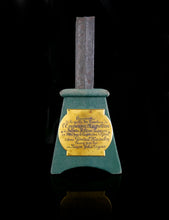A Section of Railing from Napoleon’s Tomb on St Helena, Circa 1821
Adding product to your cart
Overall: 23cm (9in)
Provenance:
Brigadier General E.F. Masselin (fl.1859-1892)
Baron Émile Bernard-Jules Legoux (1836-1908)
Cast iron, square-section, length of fluted railing (10cm (4in) long) mounted into a green baize covered wooden plinth applied with a 19th century gilt metal plaque inscribed: ‘Fragment / de la grille du Tombeau de / l’Empereur Napoléon / a Sainte Helene rapporte / en 1860 par le Capitaine du Genie depuis General Masselin / donné par lui / au Baron Jules Legoux.’ Sold with a note concerning the railing in Masselin’s hand.
Read more
Soon after seizing power by coup d’etat in 1851, Prince Louis-Napoléon (afterwards Napoleon III) received reports of the neglect effecting Longwood House and Napoleon I’s empty tomb on St Helena. In 1840 King Louis Phillipe in an attempt to garner popular support for the doomed monarchy initiated the return of Napoleon I to France for burial in Les Invalides. The St Helena tomb meanwhile reverted to the ownership of the East India Company and later the British Crown, causing Napoleon III in 1854 to open negotiations for their purchase. A price of £7,100 was agreed and the sale to the French Government was completed in 1859. The following year Captain E.F. Masselin of the 3rd Engineer Regiment was despatched to St Helena with two soldiers to repair both house and tomb. During the work which took two years Masselin, besides pocketing the present piece of railing, also sent with considerable ceremony a stone from the tomb to Washington D.C. to be included in the construction of the Washington Monument. (see http://www.nytimes.com/1860/03/03/news/the-washington-monument-a-stone-from-napoleon-s-tomb.html)
Fittingly Masselin later presented the present relic to Baron Jules Legoux, who, as leader of the Bonapartist faction in the 1890s, strove to overthrow the floundering Third Republic and resurrect Imperial rule under his ‘intimate friend’ Prince Victor Napoléon (1862-1926) aka Napoleon V. With France already bitterly and lastingly divided over the Dreyfus Affair, Legoux, who believed he carried the support of the officer corps at least, declared in Brussels, ‘The vigil is over. The hour of combat is about to sound. The moment has come when Napoleon will be in our midst and the tricolour flag will be crowned with an Imperial Eagle.’ As it was the anticipated outbreak in France did not materialise and the Third Republic survived one of its gravest crises.




